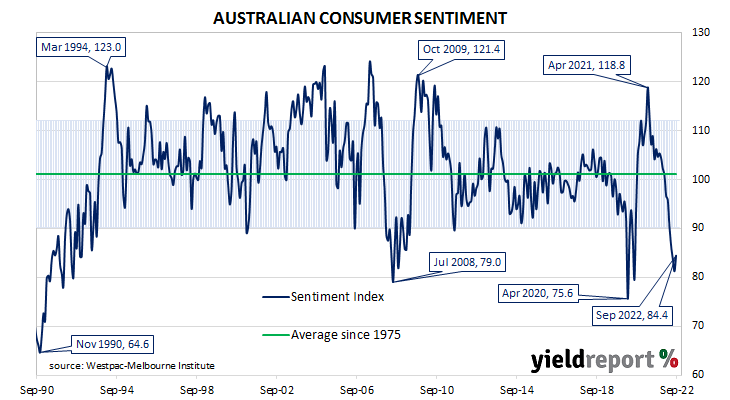Summary: Household sentiment improves after nine months of deteriorating; surprising improvement given cost of living, RBA decisions; four of five sub-indices higher; fewer respondents expecting higher jobless rate.
After a lengthy divergence between measures of consumer sentiment and business confidence in Australia which began in 2014, confidence readings of the two sectors converged again in mid-July 2018. Both measures then deteriorated gradually in trend terms, with consumer confidence leading the way. Household sentiment fell off a cliff in April 2020 but, after a few months of to-ing and fro-ing, it then staged a full recovery. However, consumer sentiment has deteriorated significantly over the past year, while business sentiment has been more robust.
According to the latest Westpac-Melbourne Institute survey conducted in early September, household sentiment has improved after deteriorating for nine consecutive months. Their Consumer Sentiment Index increased from August’s reading of 81.2 to 84.4, a reading which is still well below the range of “normal” readings and significantly lower than the long-term average reading of just over 101.
“The improvement is a little surprising, especially given continued sharp rises in the cost of living and the RBA’s decision during the survey week to make another 50bp increase in the official cash rate,” said Westpac Chief Economist Bill Evans.
Any reading of the Consumer Sentiment Index below 100 indicates the number of consumers who are pessimistic is greater than the number of consumers who are optimistic.
Commonwealth Government bond yields moved lower on the day. By the close of business, the 3-year ACGB yield had lost 4bps to 3.20%, the 10-year yield had shed 6bps to 3.58% while the 20-year yield finished 3bps lower at 3.90%.
In the cash futures market, expectations of higher rates firmed a touch. At the end of the day, contracts implied the cash rate would rise from the current rate of 2.31% to 2.59% in October and then increase to 2.92% by November. May 2023 contracts implied a 3.545% cash rate and August 2023 contracts implied 3.555%.
Four of the five sub-indices registered higher readings, with the “Economic conditions – next 12 months” sub-index posting the largest monthly percentage gain. The reading of the “Family finances – next 12 months” sub-index was the only one to decline.
The Unemployment Expectations index, formerly a useful guide to RBA rate changes, fell from 109.8 to 103.4. Lower readings result from fewer respondents expecting a higher unemployment rate in the year ahead.



